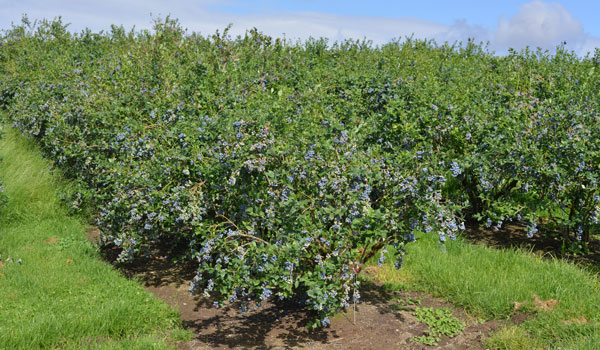
Clear Results in Organic Blueberry Research
In 2006, when Oregon State University’s Bernadine Strik began researching organic blueberry production, little information was available on the practice.
The smattering of growers producing blueberries organically were “learning on their own and learning on the fly,” said Strik, a professor in the Department Horticulture and berry research leader at the North Willamette Research and Extension Center in Aurora. “I wanted to provide them some scientific-based information.”
 The eleven-year project, which Strik wrapped up last year, looked at the effect of planting on raised beds compared to flat ground, fertilizer sources and rates and types of mulches in various cultivars in an organically certified planting. The eleven-year project, which Strik wrapped up last year, looked at the effect of planting on raised beds compared to flat ground, fertilizer sources and rates and types of mulches in various cultivars in an organically certified planting.
The three mulches studied were sawdust, which was the industry standard at the time, weed mat and yard debris compost topped with sawdust.
Strik also analyzed the effect of two different rates of nitrogen on blueberry production, including a low rate of 25 pounds to the acre and a high rate of 50 pounds to the acre at the beginning of the study. The low rate was increased to 65 pounds to the acre as plants matured and the high rate was increased to 125 pounds to the acre.
The study also looked at fish emulsion as a nitrogen source, which was applied through fertigation, and feather meal as a nitrogen source, with the feather meal containing 11-13 percent nitrogen and the fish emulsion containing 3.5 percent nitrogen.
The study’s first harvest occurred in 2008. That year’s crop and all subsequent crops through the 2016 harvest were handpicked.
Strik noted that yields stabilized beginning in year eight for both the Duke and Liberty cultivars. And in all systems, Liberty yielded better than Duke.
Raised beds had 22 percent better cumulative yields over the nine years of harvest than plants grown on flat ground, even in the good blueberry soil at the research station. Using weed mat as a mulch with irrigation underneath was the best system, because cumulative yield was slightly higher and weed-control costs were much lower, especially compared to yard-debris compost topped with sawdust.
“The yard-debris compost didn’t work as a mulch to control weeds,” she said in a presentation at the 2017 Oregon Blueberry Field Day at the Aurora research station. “There were no weed seeds in the compost, but the top layer of sawdust eroded pretty quickly and any weed seeds that blew in quickly germinated in this compost layer.”
The biggest impact found in the study was related to fertilizer. In Duke, fertilizing with feather meal led to higher yields than using fish emulsion. In Liberty, Strik found very little difference between the two nitrogen sources.
“Duke is picky when it comes to organic fertilizer source,” Strik said. “Liberty didn’t care.”
Strik also found that, particularly in Duke, the highest yields occurred with the lowest rates of fertilizer. She added, “When averaged across cultivars, the low rate of fertilizer had the higher yields.”
When it came to analyzing quality, Strik said there was no significant differences between the various systems. The rate of plant maturity also was similar between the different systems, she said.
The results of the 11-year study were clear, Strik said. “The bottom line for growers to maximize yields and reduce costs is to plant on raised beds, mulch with weed mat and fertilizer with a low rate of feather meal or fish emulsion. The key is to avoid high rates of nitrogen, especially when using only fish emulsion.”
The Pacific Northwest is now the largest organic production region for blueberries in the world. New fields are being planted on raised beds and with weed mat, and, today, the information learned in Strik’s trial is helping growers better manage fertilizer programs.
Strik said she now is moving the research in a new direction, based on the impact of these practices on soil and plant fertility.
“With ten years of data on soil and plant nutrient status, coupled with yield, we can learn a lot about what nutrients are most important,” she said. “This information will be of benefit to all growers.”
|
